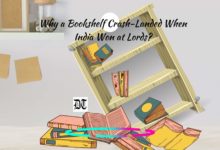Satyajit gives us an insight into spiritual art and what prompted him to paint the slokas of Sree Geeta. An exclusive for Different Truths.
This drawing is a depiction of the spiritual pictorial form of sloka from the Sree Gita. It might sound unbelievable. Some might laugh at it too. Perhaps we have never seen or heard about it. However, I tried to do something unusual.
No one attempted to represent the slokas of Sree Gita visually, in painting.
We have seen beautiful drawings relating to the Gita.
We have seen beautiful drawings relating to the Gita. These are normally the cover of Gita. Or its depiction in art exhibitions. Paintings displayed in drawing rooms, offices, hotels, shops. Possibly also in calendars, in various advertisements. Also, emblems on various household products.
Artworks and Drawings
However, these artworks and drawings, in original or prints or copies are by artists. These depict Krishna the charioteer; sad Arjuna with his bow and arrows cast away; Krishna preaching Gita to Arjuna; Sanjay describing happenings of Kurukshetra battle to blind king Dhritarastra, etc.
Usually, these are the limited subjects of Gita drawings.
We may also see paintings of Pitamaha Bhisma and other warriors blowing the conch shells. A Viswaroop Darsan. Or Krishna’s portraits or in various postures like directing Arjuna or playing the flute. Usually, these are the limited subjects of Gita drawings. We might mention here sculptures, murals, panels, depicting similar figurative forms of Krishna-Arjuna. And a few other stories from Gita on temple walls.
For the last few decades, Krishna consciousness has spread all over the world. It’s practised in several nations, irrespective of religion, caste, or creed. Parallelly, global scientists, physicists, neuroscientists, psychologists, business management gurus are all overwhelmed with the Gita. Often, they are eager to mention and quote from Gita in their speeches and write-up.
Discourses on Gita
We heard many discourses on Gita by scholars, spiritual gurus, and philosophical pundits. Their profound wisdom on spiritual, philosophical, psychological behavioural explanations of human beings, as mentioned in the Gita. There is even an hour-long discourse on a single sloka.
I wondered where the actual and main contents were? When the Gita is a composition of 700 slokas representing unique meanings of life, divine and spiritual thoughts, then why are there no drawings of those splendid slokas? In fact, there are no spiritual, philosophical, and pictorial revelations of Gita’s slokas in drawings. We have repetitive reproduction and rearrangement of handful figurative subjects of Gita. To me these are of limited importance, in comparison to the basic contents, the slokas.
Spiritual Art Form
To be more practical, contents and meanings of Gita slokas emphasising spiritual, philosophical, dharmic vachanas are nearly impossible to determine. It’s very difficult to give visual shapes and forms. Unless, however, the very drawing process itself is a spiritual art form.
These are limited to illustrative physicals, though beautifully drawn…
The present-day art world may not accept this interpretation. But the different truth is art pieces and drawings, we see as of Gita, are mainly the creation of conventional institutional art forms. These are limited to illustrative physicals, though beautifully drawn with superb art and craft sense and skill. But these depict only the external physical forms.
Let me illustrate my point. If an artist is asked to draw a Gita sloka starting with, ‘Sree Bhagaban uvacha…’ (Srikrishna said), then and there the artist draws a beautiful portrait of Krishna illustrating a talking face with sweet smiles. But when given in continuation of the sloka that follows, atha chainang nityajato nityang ba manyasase mritam / tathapi twang mahabaho nainang sochitumrhosi. It means, ‘If you think that Atma is born and dies in regular course, even then, O valiant Arm (Arjuna), you cannot repent but fight the battle.’
Crafting Anubhava
Can artists craft this anubhava (experience) accrued with deeper meanings? Perhaps not. Since it is beyond physical and figurative expression but a philosophical revelation knowing Atma’s permanence one must fight his battle. Therefore, there are no drawings of the rest of the 700 slokas that define spiritual meanings.
There are spiritual art forms and seeker artists.
There are spiritual art forms and seeker artists. They are engaged in secretly practicing the drawing of sadhana. And they care not to display their drawings. They believe in sincerity that drawings are sacred, but only for practicing. Practicing for attaining the goal of Atma-sakshatkar – a seeker’s journey to the self, the ultimate Chaitanya Sattva – origin of all brewing arts.
A brief and selected portion from the introduction of a book titled, Sree Vidya Arts on Sree Gita, may highlight better understanding on the subject.
Spark of Thought
One bright autumn evening, when I was returning home, pedalling through the daily course of twenty km stretch of urban-rural connector road, crossing three highways, suddenly, a sloka flashed in mind, Na rupamasyeha tathopa lavyate nanto na chadihna cha sampratistha… (15/3). With this spark of thought that Purushottama Yoga emphasises too, “the root of the desire tree is to be cut, to be de-rooted. Oneness of God is not attainable through the indriya (sense) oriented material expression of shapes and forms’.
Drawings of each sloka then used to pour out so effortlessly.
By that time I was in progress with the drawings. Drawings of each sloka then used to pour out so effortlessly. My duty was just to sit for drawing and chant the sloka internally. I even felt that the mantra was itself forcing the hand to revolve in its own course. My conscious self was just an onlooker – a sakshi – mere witness to movements of the pranik rhythm, which finally creates a visual effect of sublime form.
This art process is a sadhana. Mastering application of ‘passivity and surrender’ through brush, drawings of rhythmic force of prana – the vital force. The pivotal Shakti is at its liberty and detached from nature’s material wish. Material wish is in continuous deliberation of mind to give shape, and to pay no heed to that shape is ‘passivity’. ‘Surrender’ is – submission to that pranik Shakti, the vital force.
When the process is ripe, then the freedom of prana-chhanda … revolves to draw the sublime expression…
Sublime Expression
When the process is ripe, then the freedom of prana-chhanda (rhythm of the vital force) revolves to draw the sublime expression of attaining the lotus feet – “tat padam tat parimargitabyam jasmin gat na nibartanti vuah…”
To conclude, the drawing piece exhibited at the beginning, which was the issue for this long discussion, is revelation of the artwork of the sloka from Sankha Yoga, 2nd chapter of the Gita, that is:
अथ चैनं नित्यजातं नित्यं वा मन्यसे मृतम्। तथापि त्वं महावाहो नैनं शोचितुमर्हसि।।
Visuals by the author-artist





 By
By
 By
By
 By
By
 By
By